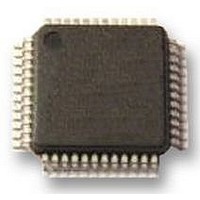LPC2106FBD48/01 NXP Semiconductors, LPC2106FBD48/01 Datasheet - Page 12

LPC2106FBD48/01
Manufacturer Part Number
LPC2106FBD48/01
Description
IC, MCU, 32BIT, 128K FLASH, 48LQFP
Manufacturer
NXP Semiconductors
Datasheet
1.LPC2105FBD48.pdf
(41 pages)
Specifications of LPC2106FBD48/01
Controller Family/series
ARM7
No. Of I/o's
32
Ram Memory Size
64KB
Cpu Speed
60MHz
No. Of Timers
3
No. Of Pwm
RoHS Compliant
Core Size
32bit
Program Memory Size
128KB
Oscillator Type
Internal, External
Available stocks
Company
Part Number
Manufacturer
Quantity
Price
Company:
Part Number:
LPC2106FBD48/01
Manufacturer:
NXP
Quantity:
670
Company:
Part Number:
LPC2106FBD48/01
Manufacturer:
NXP
Quantity:
7 750
Company:
Part Number:
LPC2106FBD48/01,15
Manufacturer:
NXP
Quantity:
250
Company:
Part Number:
LPC2106FBD48/01,15
Manufacturer:
NXP Semiconductors
Quantity:
10 000
NXP Semiconductors
LPC2104_2105_2106_7
Product data sheet
6.5.1 Interrupt sources
6.5 Interrupt controller
The Vectored Interrupt Controller (VIC) accepts all of the Interrupt Request (IRQ) inputs
and categorizes, them as FIQ, vectored IRQ, and non-vectored IRQ as defined by
programmable settings. The programmable assignment scheme means that priorities of
interrupts from the various peripherals can be dynamically assigned and adjusted.
Fast Interrupt reQuest (FIQ) has the highest priority. If more than one request is assigned
to FIQ, the VIC combines the requests to produce the FIQ signal to the ARM processor.
The fastest possible FIQ latency is achieved when only one request is classified as FIQ,
because then the FIQ service routine can simply start dealing with that device. But if more
than one request is assigned to the FIQ class, the FIQ service routine can read a word
from the VIC that identifies which FIQ source(s) is (are) requesting an interrupt.
Vectored IRQs have the middle priority. Sixteen of the interrupt requests can be assigned
to this category. Any of the interrupt requests can be assigned to any of the 16 vectored
IRQ slots, among which slot 0 has the highest priority and slot 15 has the lowest.
Non-vectored IRQs have the lowest priority.
The VIC combines the requests from all the vectored and non-vectored IRQs to produce
the IRQ signal to the ARM processor. The IRQ service routine can start by reading a
register from the VIC and jumping there. If any of the vectored IRQs are requesting, the
VIC provides the address of the highest-priority requesting IRQs service routine,
otherwise it provides the address of a default routine that is shared by all the non-vectored
IRQs. The default routine can read another VIC register to see what IRQs are active.
Table 4
one interrupt line connected to the Vectored Interrupt Controller, but may have several
internal interrupt flags. Individual interrupt flags may also represent more than one
interrupt source.
Table 4.
Block
WDT
-
ARM Core
ARM Core
Timer 0
Timer 1
UART 0
lists the interrupt sources for each peripheral function. Each peripheral device has
Interrupt sources
Flag(s)
Watchdog Interrupt (WDINT)
Reserved for software interrupts only
EmbeddedICE, DbgCommRx
EmbeddedICE, DbgCommTx
Match 0 to 3 (MR0, MR1, MR2, MR3)
Capture 0 to 2 (CR0, CR1, CR2)
Match 0 to 3 (MR0, MR1, MR2, MR3)
Capture 0 to 3 (CR0, CR1, CR2, CR3)
Rx Line Status (RLS)
Transmit Holding Register empty (THRE)
Rx Data Available (RDA)
Character Time-out Indicator (CTI)
Auto-Baud Time-Out (ABTO)
End of Auto-Baud (ABEO)
Rev. 07 — 20 June 2008
[1]
[1]
LPC2104/2105/2106
Single-chip 32-bit microcontrollers
© NXP B.V. 2008. All rights reserved.
VIC channel #
0
1
2
3
4
5
6
12 of 41
















